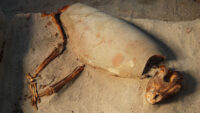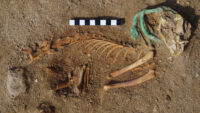 Excavations of the pet cemetery in the Red Sea port town of Berenike have unearthed the remains of 585 clearly identified individuals. There were even more, but those remains were destroyed or too incomplete to count.
Excavations of the pet cemetery in the Red Sea port town of Berenike have unearthed the remains of 585 clearly identified individuals. There were even more, but those remains were destroyed or too incomplete to count.
The pet cemetery was discovered in 2011 northwest of the walls of the Roman-era town. Unlike other Egyptian sites where the remains of animals were found, these animals were not mummified, nor temple offerings, nor deliberately killed. Other animal burial sites in the Nile Valley also include human burials; this one does not.
The site on the outskirts of town was used a trash dump but the animals were not thrown away like garbage. They were lovingly buried, intentionally posed in a sleeping position, and often covered with pieces of pottery. Most of them were individual burials, although there are several group burials, mostly of kittens. There are no grave goods, but they were frequently buried wearing collars of iron (only found on cats and monkeys) and bronze and beaded necklaces. Some of the burials included the remains of other animals, like the cat buried on the wing of a large bird.
The trash layers were useful in dating the pet burials, narrowing down its use as a pet cemetery from the mid-1st century through the mid-2nd century. During that period, people buried 536 cats, 32 dogs, 16 monkeys, one Rüppell’s fox and one Barbary falcon.
Most of the dogs are of medium size comparable to a Spitz type. One exception was taller with a longer skull, similar in morphology to modern-day Pharaoh hounds which are sighthounds used to hunt small game. Another exception went in the other direction: it was a miniature breed of a Maltese type. It is the only toy dog ever found in Egypt. The majority of the dogs lived to maturity, several to old age, long past the time when they could be used as hunting and sporting dogs.
 Analysis of the remains found that the vast majority of the cats roamed outdoors, but they were definitely pets. They had their wounds treated, wore ornamental collars and were fed with selected foods. There’s even written evidence found on an ostracon at another site from early Roman Berenike: “Herennius to Satornilus his dearest, greetings (…) Concerning the cats, Ourses is taking care of them in accordance with what I also wrote you on another occasion.” Even so, the cats died a lot younger than the dogs did. This is likely due to infectious diseases that spread easily among the much larger feline population, resulting in high mortality among young animals.
Analysis of the remains found that the vast majority of the cats roamed outdoors, but they were definitely pets. They had their wounds treated, wore ornamental collars and were fed with selected foods. There’s even written evidence found on an ostracon at another site from early Roman Berenike: “Herennius to Satornilus his dearest, greetings (…) Concerning the cats, Ourses is taking care of them in accordance with what I also wrote you on another occasion.” Even so, the cats died a lot younger than the dogs did. This is likely due to infectious diseases that spread easily among the much larger feline population, resulting in high mortality among young animals.
In broad perspective, the discoveries from Berenice make it possible to test the theses dominating scientific discourse on the human-animal relationship in antiquity. In particular, the concepts of ‘pets’ and ‘companion animal’ need to be a subject of new debate. Of course, one cannot clearly transpose the situation in a socially and culturally specific peripheral port to the general situation in the ancient Roman world. Nevertheless, strong evidence, archaeozoological, veterinary and textual, clearly indicate that the people living in Berenice nearly two thousand years ago looked after ‘non-utilitarian’ animals in similar ways as today. We are able to clearly identify and recognize the relationships between humans and animals whose only task could have been providing a person with companionship, perhaps emotional entertainment. In this respect, the results of our research enrich our knowledge of the ancient world not only in the field of archaeozoology and veterinary medicine, but also classical archaeology and ancient history.